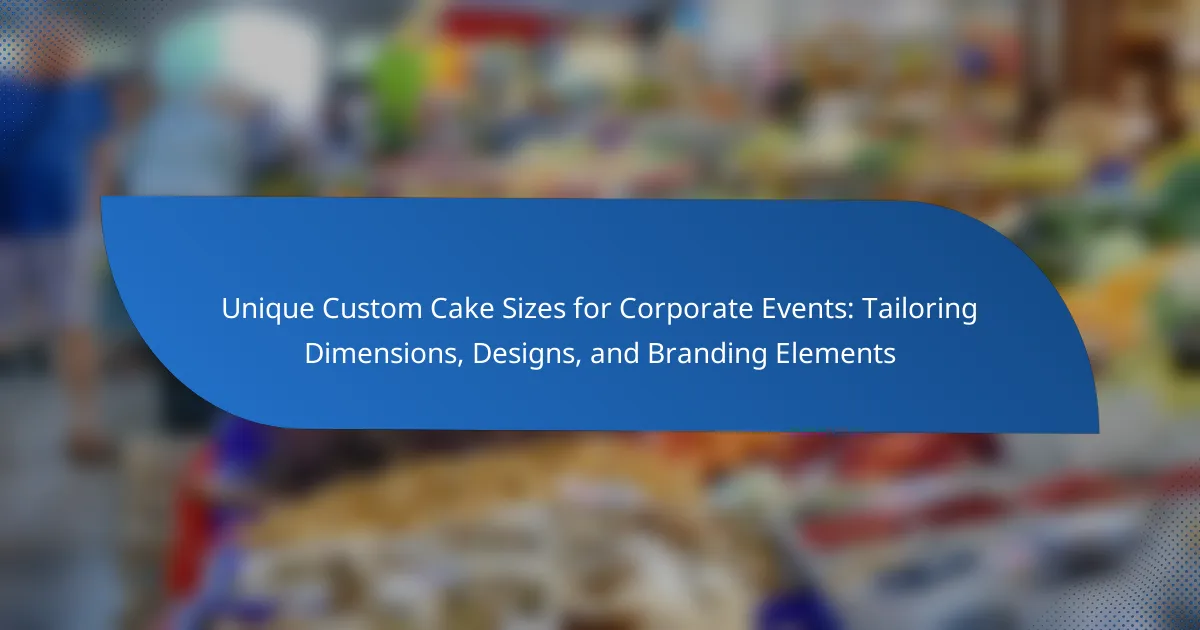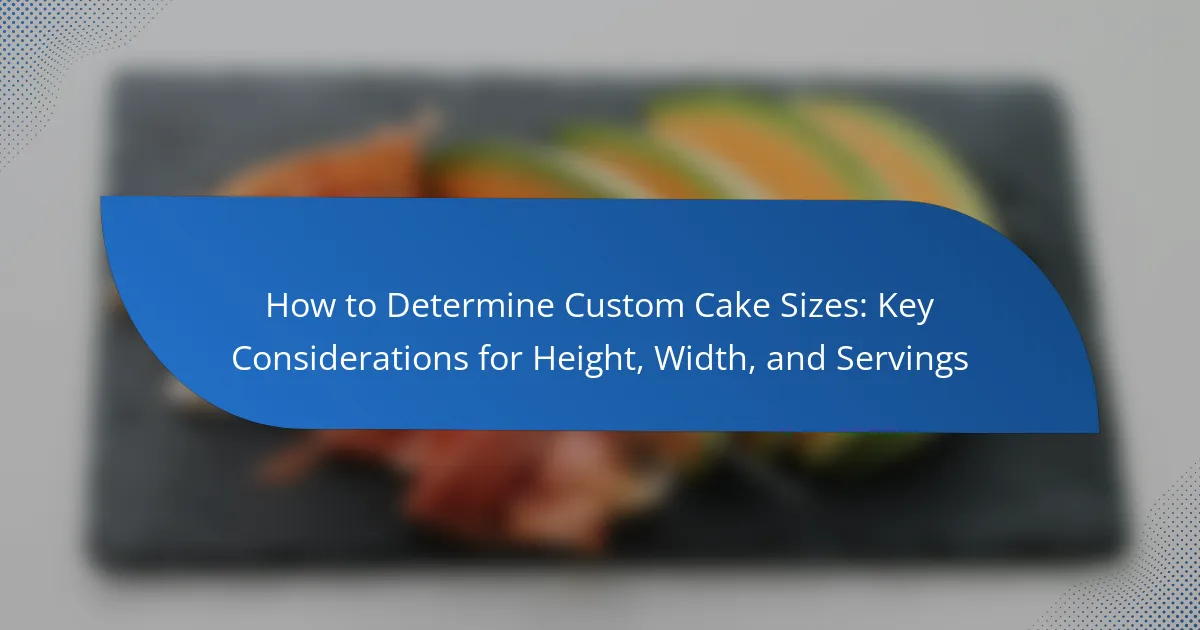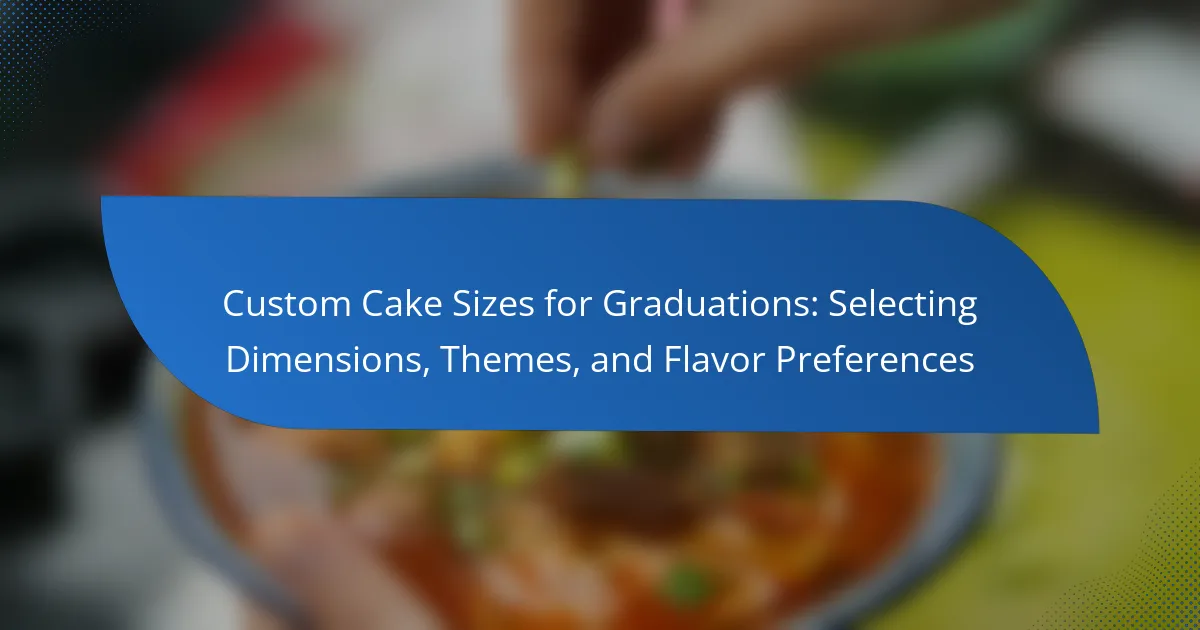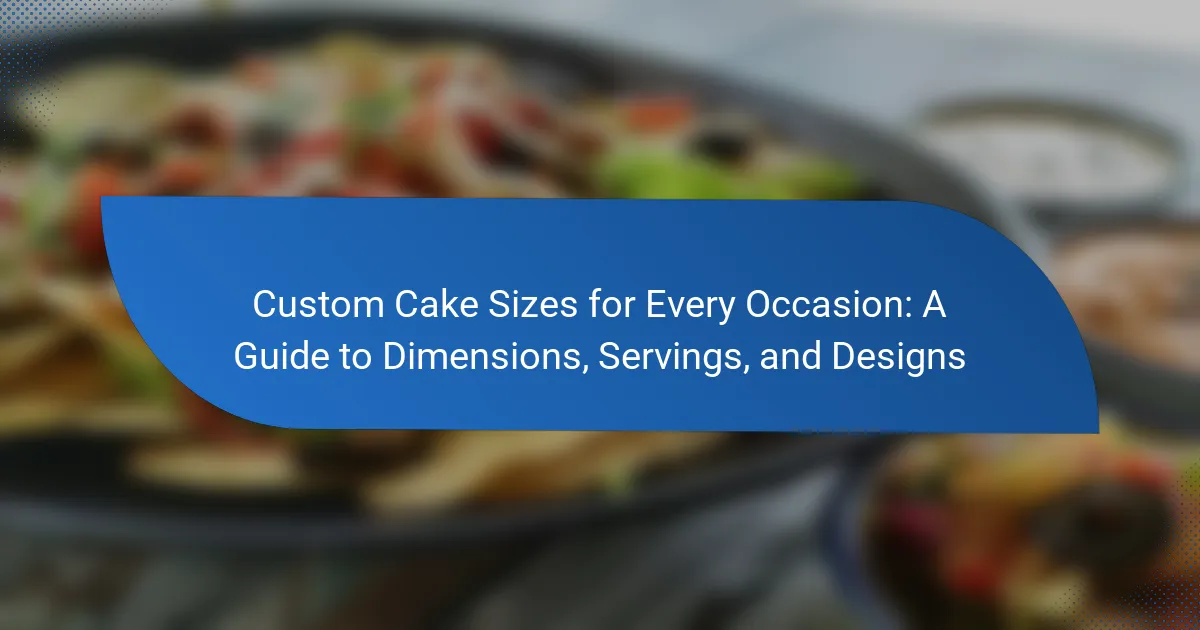The article focuses on custom cake sizes for weddings, detailing how different tier sizes accommodate various guest counts. Typical wedding cake sizes range from 6-inch to 16-inch tiers, with a three-tier cake serving around 100 guests and a five-tier cake serving approximately 200 guests. It emphasizes the importance of considering guest count, serving sizes, and design preferences when selecting a cake. Additionally, the article addresses how flavor options can influence cake size and aesthetic appeal, ensuring a balance between visual impact and sufficient servings for guests.
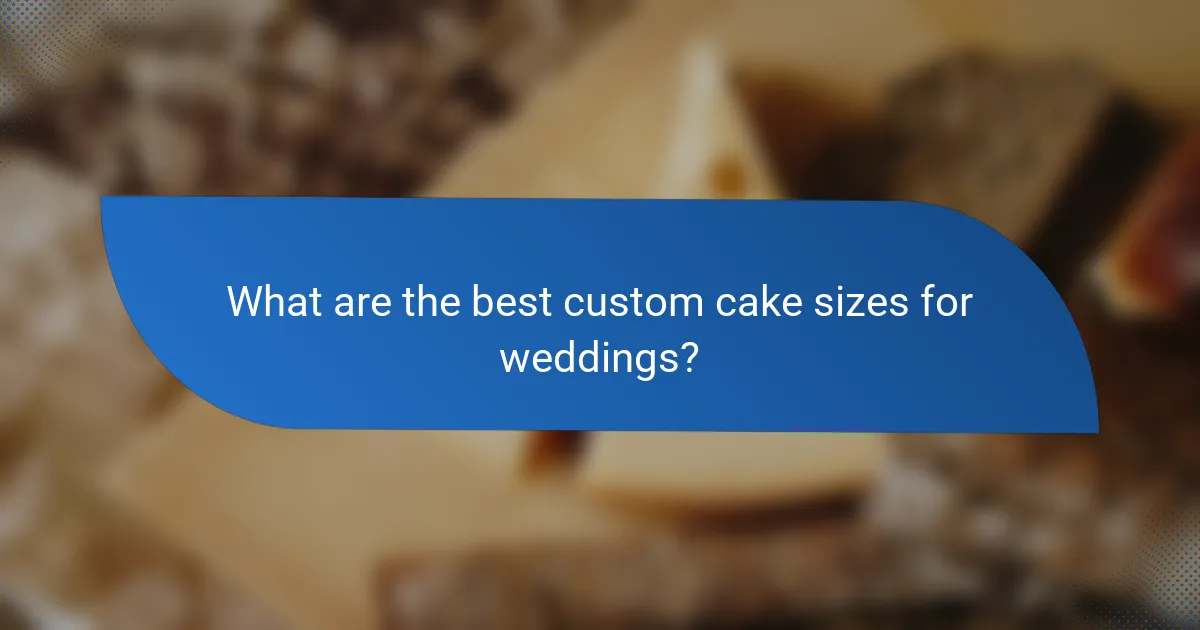
What are the best custom cake sizes for weddings?
The best custom cake sizes for weddings typically range from 6-inch to 16-inch tiers. A common choice is a three-tier cake, serving approximately 100 guests. For larger weddings, a five-tier cake can accommodate around 200 guests. Each tier typically serves a specific number of guests based on its diameter. A 6-inch tier serves about 10-12 guests, while a 10-inch tier serves 30-40 guests. The larger 14-inch and 16-inch tiers can serve 60-80 guests each. These sizes allow for a balance of aesthetic appeal and adequate servings. Custom sizes can also be adjusted based on guest count and design preferences.
How do guest counts influence cake size selection?
Guest counts directly influence cake size selection. Larger guest counts require bigger cakes to ensure everyone is served. A standard serving size is typically one slice per person. For example, a cake serving 50 guests usually needs to be at least 6 inches tall. Additionally, bakeries often provide size charts to match guest counts with appropriate cake dimensions. This ensures that the cake is not only visually appealing but also sufficient for the occasion. Accurate guest counts help avoid waste or shortages of cake at events.
What is the general guideline for cake servings per guest?
The general guideline for cake servings per guest is one slice per person. This is the standard recommendation for most events, including weddings. A typical wedding cake slice is about 1 inch by 2 inches. This size allows for adequate servings while accommodating various guest appetites. For larger weddings, some planners suggest having extra servings for larger guests or those who may want seconds. It is also common to consider the type of cake and its richness when determining servings. For example, richer cakes may require smaller slices. Overall, planning for one slice per guest is a reliable approach.
How do different cake styles affect portion sizes?
Different cake styles directly influence portion sizes. For instance, tiered cakes typically serve more guests due to their multi-layer design. Each tier can be cut into smaller slices, increasing the total servings. In contrast, single-layer cakes offer fewer servings because they lack additional layers for cutting.
Moreover, the shape of the cake affects portion sizes. Round cakes generally yield more slices than square cakes of the same diameter. Research indicates that a standard round cake can serve approximately 12-16 people, while a square cake can serve around 9-12, depending on the size.
Additionally, specialty cakes, like those with intricate designs or fillings, may be cut into smaller portions to maintain aesthetic appeal. This can lead to a higher number of servings per cake. Therefore, understanding the relationship between cake style and portion size is crucial for event planning.
What flavor options are popular for wedding cakes?
Popular flavor options for wedding cakes include vanilla, chocolate, and red velvet. Vanilla is a classic choice, known for its light and sweet taste. Chocolate offers a rich and indulgent flavor, appealing to many guests. Red velvet has a unique flavor profile, combining cocoa with a hint of tanginess. Other popular flavors are lemon, almond, and carrot. Lemon provides a fresh and zesty option, while almond adds a nutty richness. Carrot cake is often favored for its moist texture and spices. These flavors cater to diverse palates, ensuring guests enjoy their cake experience.
How do flavor choices impact cake size and design?
Flavor choices directly influence cake size and design. Different flavors may require specific ingredients, affecting the cake’s density and structure. For example, dense flavors like chocolate may need a smaller size to maintain stability. Conversely, lighter flavors such as vanilla can allow for larger designs without compromising stability.
Additionally, flavor combinations can dictate the number of tiers in a cake. Multi-flavor cakes often feature distinct layers, which can increase both size and visual appeal. A cake designed to showcase various flavors may necessitate a more intricate design, including decorations that highlight each flavor.
Furthermore, certain flavors can be more popular among guests, impacting the overall size needed to accommodate servings. According to industry standards, a cake serving typically weighs about 4 ounces per guest. Therefore, a cake designed with a popular flavor may require a larger size to ensure all guests are satisfied.
In summary, flavor choices significantly affect the size and design of cakes by influencing structural requirements, tier arrangements, and serving sizes.
What are the most requested flavors for wedding cakes?
The most requested flavors for wedding cakes include vanilla, chocolate, and red velvet. Vanilla is popular for its classic taste and versatility. Chocolate offers a rich flavor that many couples love. Red velvet stands out for its unique color and mild cocoa flavor. Other frequently requested flavors are lemon, carrot, and almond. Lemon provides a refreshing taste, while carrot adds a hint of spice. Almond is favored for its distinct nutty flavor. These flavors are commonly chosen based on surveys from bakeries and wedding planners, reflecting current trends in wedding cake preferences.
How does aesthetic appeal factor into cake size decisions?
Aesthetic appeal significantly influences cake size decisions. Larger cakes often create a more visually impressive display. A bigger cake allows for intricate designs and multiple tiers. This enhances the overall presentation at events like weddings. Additionally, larger cakes can accommodate decorative elements such as flowers or figurines. These features contribute to the cake’s visual impact. A study by The Knot indicates that 40% of couples prioritize cake design in their planning. Thus, aesthetic considerations often lead to selecting larger cake sizes.
What trends are influencing wedding cake designs?
Current trends influencing wedding cake designs include minimalism, bold colors, and floral elements. Minimalist designs emphasize simplicity and elegance. They often feature clean lines and a limited color palette. Bold colors are becoming popular, moving away from traditional whites and pastels. These vibrant hues add a modern touch to wedding cakes. Floral elements are also trending, with natural blooms incorporated into designs. This trend highlights organic beauty and personalization. Additionally, unique flavors are gaining popularity, with couples opting for non-traditional cake flavors. These trends reflect a shift towards individuality and creativity in wedding celebrations.
How can a cake’s appearance complement wedding themes?
A cake’s appearance can enhance wedding themes by aligning its design with the overall aesthetic of the event. For instance, a rustic wedding theme may feature a cake adorned with natural elements like flowers and wood accents. Conversely, a glamorous theme might call for a cake decorated with metallic finishes and intricate detailing. The color palette of the cake can also reflect the wedding’s color scheme, ensuring visual harmony. Specific cake styles, such as tiered or minimalist designs, can complement various themes effectively. Research indicates that cohesive design elements can improve overall guest experience and satisfaction.
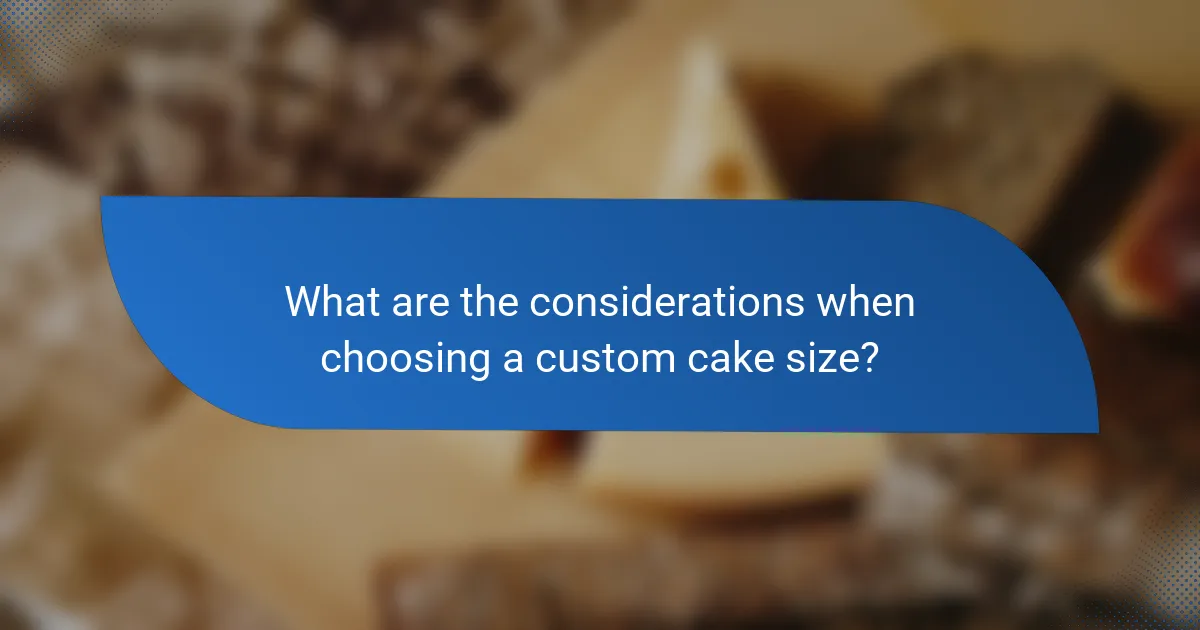
What are the considerations when choosing a custom cake size?
Considerations when choosing a custom cake size include guest count, serving size, and design. Guest count determines how many servings are needed. A standard serving size is typically 1 slice per person. The cake’s design may require additional size for tiers or embellishments. Flavor options can also influence size, as multiple flavors may necessitate larger cakes for variety. Lastly, aesthetic appeal can dictate size to match the overall wedding theme. For example, a larger cake may create a more dramatic visual impact.
How do budget constraints affect cake size and flavor?
Budget constraints directly limit the size and flavor options of a cake. When budgets are tight, consumers often opt for smaller cakes to reduce costs. A smaller cake typically serves fewer guests, which can influence the overall design and presentation. Flavor choices may also be restricted, as premium ingredients can increase the cake’s price. For example, gourmet flavors like chocolate truffle or red velvet may be less affordable than standard vanilla or chocolate. Additionally, intricate designs often require more time and resources, further increasing costs. Therefore, budget constraints can lead to simpler cakes that may not fully reflect the desired aesthetic or flavor variety.
What are the average costs associated with different cake sizes?
The average costs associated with different cake sizes vary significantly. A small cake serving 10-15 people typically costs between $30 to $50. A medium cake serving 30-40 people usually ranges from $100 to $200. A large cake serving 70-100 people can cost anywhere from $300 to $600. The price is influenced by factors such as ingredients, design complexity, and regional pricing trends. Customization options like flavors and decorations can also increase costs. For example, a tiered cake with elaborate designs may exceed the average range. These estimates are based on industry standards and can fluctuate based on specific bakeries and locations.
How can couples balance quality and quantity in their cake selection?
Couples can balance quality and quantity in their cake selection by choosing a tiered cake design. A tiered cake allows for multiple flavors while maintaining an elegant appearance. Couples should select a smaller top tier for display and a larger bottom tier for serving. This approach ensures that guests enjoy high-quality cake without compromising on serving size. Additionally, couples can supplement the cake with dessert tables featuring smaller treats. This strategy provides variety while keeping the main cake as a focal point. Ultimately, this method combines aesthetic appeal with sufficient servings for guests.
What role does the venue play in determining cake size?
The venue significantly influences cake size due to guest capacity and space limitations. Larger venues typically accommodate more guests, necessitating a bigger cake. Conversely, smaller venues may require a smaller cake to fit the space available. Additionally, the layout of the venue affects cake placement and visibility. For instance, a prominent display area may call for a larger cake for aesthetic appeal. The overall theme and decor of the venue also dictate cake size, as a grand venue may warrant an extravagant cake. Therefore, the venue’s characteristics directly impact the decision on cake size to ensure it complements the event.
How can venue layout influence cake display and serving?
Venue layout significantly influences cake display and serving. An open layout allows for a more prominent cake presentation. This visibility can enhance the overall aesthetic appeal of the event. Conversely, a cramped or obstructed layout may hinder guests’ ability to see or access the cake.
Additionally, the proximity of the cake to dining areas affects serving efficiency. If the cake is too far from the tables, it can delay serving time. A well-planned layout can facilitate smoother traffic flow for guests during cake cutting.
Moreover, different venue configurations, such as round tables versus long banquet tables, can impact how the cake is showcased. For example, round tables may allow for a 360-degree view of the cake. This can create a more inviting atmosphere.
In summary, effective venue layout maximizes cake visibility and accessibility, enhancing the overall experience for guests.
What are the logistical considerations for cake transport to the venue?
The logistical considerations for cake transport to the venue include stability, temperature control, and timing. Stability is crucial to prevent damage during transit. Cakes should be secured in a sturdy box or carrier. Temperature control is important to maintain the cake’s integrity. Most cakes require a cool environment, especially those with perishable ingredients. Timing is also vital; cakes should be delivered as close to the event as possible. This minimizes the risk of deterioration. Additionally, the route should be planned to avoid bumpy roads. Finally, having a backup plan for emergencies, like traffic delays, can ensure timely arrival.
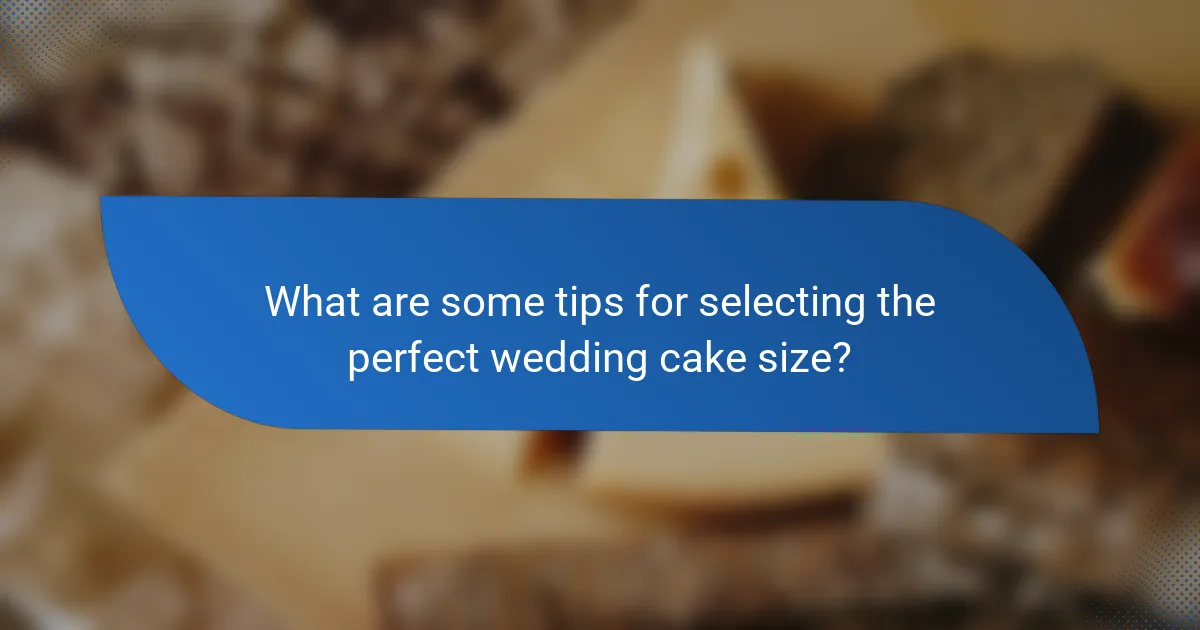
What are some tips for selecting the perfect wedding cake size?
To select the perfect wedding cake size, consider the number of guests. A standard serving size is about 1 slice per person. Multiply the guest count by the serving size to determine the total slices needed. Factor in additional servings for larger cake tiers or elaborate designs. Remember that different cake styles yield varying slice sizes. For example, a tiered cake typically serves more than a single-layer cake. Additionally, consult with your baker for specific recommendations based on their cake style. This ensures you achieve the desired aesthetic while satisfying your guest count.
How can couples ensure they choose the right size for their needs?
Couples can ensure they choose the right cake size by determining their guest count first. Accurate guest counts help in estimating the necessary portions. A standard serving size for wedding cake is about 1 inch by 2 inches. Couples should also consider their preferred cake flavors and styles. Different flavors may require different amounts of cake to satisfy guests. Additionally, couples can consult with their baker for recommendations based on guest count and cake design. Bakeries often provide serving charts to guide couples in selecting sizes. This method ensures that the cake meets both aesthetic and practical needs.
What are common mistakes to avoid when selecting cake sizes?
Common mistakes to avoid when selecting cake sizes include underestimating guest count. Many people fail to account for all attendees, leading to insufficient servings. Another mistake is not considering cake tiers. A single-tier cake may not provide enough servings for larger gatherings. Additionally, neglecting portion sizes can result in too little cake for guests. Many assume standard slice sizes without factoring in personal preferences. Misjudging the cake’s design can also be problematic. A visually appealing cake may require more servings than a simple design. Lastly, ignoring dietary restrictions can leave guests without options. It’s essential to consider allergies and preferences when finalizing cake sizes.
How can couples effectively communicate their preferences to bakers?
Couples can effectively communicate their preferences to bakers by being clear and specific about their needs. They should start by discussing the guest count to determine the appropriate cake size. Providing flavor preferences is essential, as bakers often have a range of options available. Couples should also share any dietary restrictions, such as gluten-free or vegan requirements. Visual aids, like pictures of preferred cake designs, can help convey aesthetic preferences. Additionally, discussing budget constraints upfront ensures bakers can suggest suitable options. Clear communication fosters collaboration and helps bakers create a cake that meets the couple’s vision.
What are the best practices for ordering a custom wedding cake?
The best practices for ordering a custom wedding cake include early planning, clear communication, and tasting sessions. Start by determining your budget and guest count. This helps in selecting the right size and design. Research local bakers and read reviews to find a reputable vendor. Schedule a tasting to explore flavor options and assess quality. Provide the baker with your wedding theme and color scheme for a cohesive design. Discuss any dietary restrictions of guests, such as gluten-free or vegan options. Confirm the delivery details and setup arrangements well in advance. Finally, review the contract carefully before signing to ensure all details are accurate.
The main entity of this article is custom wedding cakes, with a focus on their sizes, guest count, flavor options, and aesthetic appeal. The article outlines the best custom cake sizes for weddings, detailing how guest counts influence cake selection and serving guidelines. It explores popular flavor choices and their impact on cake size and design, while also addressing aesthetic considerations and current trends in wedding cake designs. Additionally, logistical factors such as venue layout and budget constraints are examined to help couples make informed decisions when selecting the perfect wedding cake.
